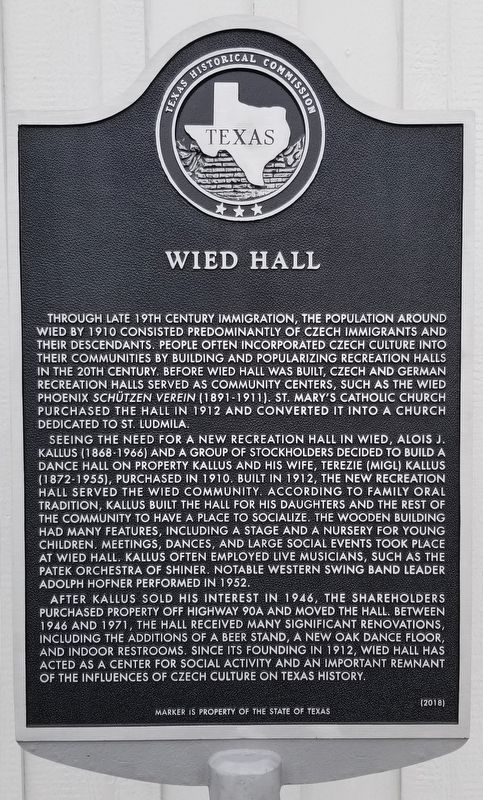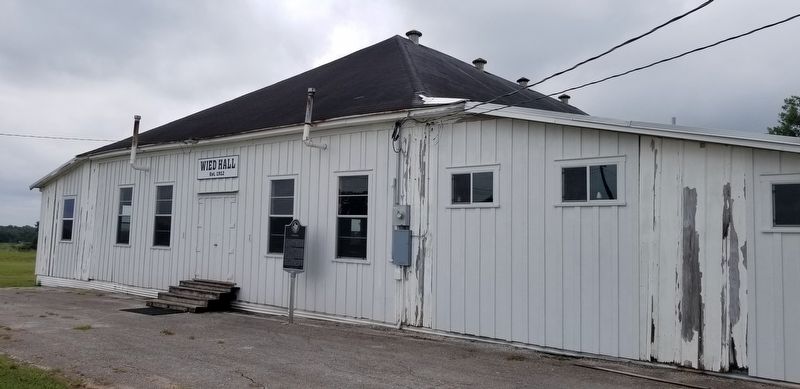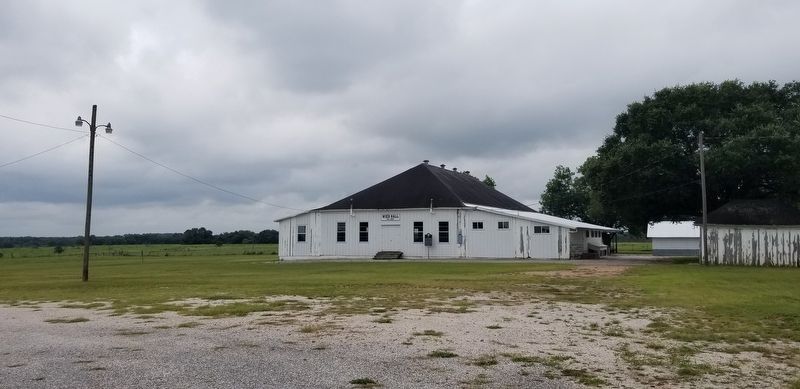Near Wied in Lavaca County, Texas — The American South (West South Central)
Wied Hall
Through late 19th century immigration, the population around Wied by 1910 consisted predominantly of Czech immigrants and their descendants. People often incorporated Czech culture into their communities by building and popularizing recreation halls in the 20th century. Before Wied hall was built, Czech and German recreation halls served as community centers, such as the Wied Phoenix Schützen Verein (1891-1911). St. Mary's Catholic Church purchased the hall in 1912 and converted it into a church dedicated to St. Ludmila.
Seeing the need for a new recreation hall in Wied, Alois J. Kallus (1868-1966) and a group of stockholders decided to build a dance hall on property Kallus and his wife, Terezie (Migl) Kallus (1872-1955), purchased in 1910. Built in 1912, the new recreation hall served the Wied community. According to family oral tradition, Kallus built the hall for his daughters and the rest of the community to have a place to socialize. The wooden building had many features, including a stage and a nursery for young children. Meetings, dances, and large social events took place at Wied Hall. Kallus often employed live musicians, such as the Patek Orchestra of Shiner. Notable Western Swing Band leader Adolph Hofner performed in 1952.
After Kallus sold his interest in 1946, the shareholders purchased property off Highway 90A and moved the hall. Between 1946 and 1971, the hall received many significant renovations, including the additions of a beer stand, a new oak dance floor, and indoor restrooms. Since its founding in 1912, Wied Hall has acted as a center for social activity and an important remnant of the influences of Czech culture on Texas history.
Erected 2018 by Texas Historical Commission. (Marker Number 20074.)
Topics. This historical marker is listed in these topic lists: Arts, Letters, Music • Entertainment. A significant historical year for this entry is 1910.
Location. 29° 25.643′ N, 97° 3.152′ W. Marker is near Wied, Texas, in Lavaca County. Marker is on Alternate U.S. 90, 0.1 miles west of County Highway 177, on the left when traveling west. The marker is located next to the front entrance to the hall. Touch for map. Marker is in this post office area: Shiner TX 77984, United States of America. Touch for directions.
Other nearby markers. At least 8 other markers are within 7 miles of this marker, measured as the crow flies. Witting School (approx. 5.7 miles away); William Smothers (approx. 5.8 miles away); Sarah Creath McSherry Hibbens Stinnett Howard (approx. 6.3 miles away); Site of Oak Grove School (approx. 6.6 miles away); First Methodist Church of Shiner (approx. 6.6 miles away); First National Bank of Hallettsville (approx. 6.7 miles away); Richardson Chapel United Methodist Church (approx. 6.7 miles away); The Wreck of the Don Milo (approx. 6.7 miles away).
Also see . . . Wied, TX.
Wied is on Farm Road 1891 just north of U.S. Highway 90A, midway between Hallettsville and Shiner in west central Lavaca County. The first settlers in the area were John Smeathers, who arrived in 1832, and Francis Smith, who arrived in 1835. Soon after Texas independence Anthony Brown and Moses Mitchell joined them. These Anglo-Americans from the southern United States found that the well-watered and well-drained rolling prairieland between Ponton and Smeathers creeks provided excellent pasture for horses and cattle and, when cultivated, produced good crops of cotton and corn. By 1873 German immigrants had replaced most of the original occupants and divided the ranches into farms. A community with a blacksmith shop, a store, and a cotton gin developed on land owned by the Wied brothers and took their name. A post office operated in the store from 1889 until 1906. Czech immigrants arriving in the 1880s and 1890s soon balanced the German population. Source: The Handbook of Texas
(Submitted on August 11, 2021, by James Hulse of Medina, Texas.)
Credits. This page was last revised on August 11, 2021. It was originally submitted on August 11, 2021, by James Hulse of Medina, Texas. This page has been viewed 267 times since then and 92 times this year. Photos: 1, 2, 3. submitted on August 11, 2021, by James Hulse of Medina, Texas.


